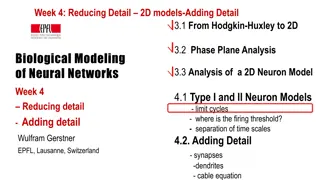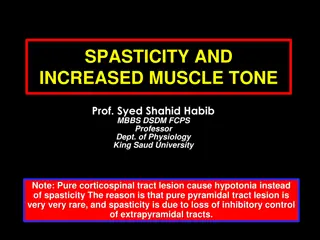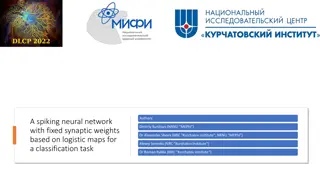
Mice Neuron Study: Synapse Characteristics and Rise Times Analysis
Dive into a fascinating research project exploring the effects of whisker deprivation on mice neurons, focusing on rise time, decay time, and amplitude as key variables of interest. Discover how synapse location impacts rise times and how IPSCs and EPSCs density plots provide valuable insights into neuronal responses.
Download Presentation

Please find below an Image/Link to download the presentation.
The content on the website is provided AS IS for your information and personal use only. It may not be sold, licensed, or shared on other websites without obtaining consent from the author. If you encounter any issues during the download, it is possible that the publisher has removed the file from their server.
You are allowed to download the files provided on this website for personal or commercial use, subject to the condition that they are used lawfully. All files are the property of their respective owners.
The content on the website is provided AS IS for your information and personal use only. It may not be sold, licensed, or shared on other websites without obtaining consent from the author.
E N D
Presentation Transcript
Team: Andrew Crossett and Steve Wasik Collaborator: Alison Barth (Biology Department, CMU) Advisor: Brian Junker
Three Groups of Mice Control Mice have no whiskers removed Spared Mice have all but one whisker removed, Neurons extracted are from are of brain that maps to that specific whisker Deprived Mice have all but one whisker removed, Neurons extracted are in proximity to the neurons extracted for Spared
Collecting the Data Mice are split into the three groups, and then kept alive for a given period. Neurons from their neocortexs are then collected Two types of neurons collected Excitatory: Faster Rise and Decay times Inhibitory: Slower Rise and Decay times The recorded characteristics of the action potential at the synapses are: Rise time, Decay time, Amplitude
Variables of Interest Rise time a proxy for measure of distance from cell body to the receiving synapse Decay time hypothesized to be a measure of strength of connection Amplitude importance of neuron fosGFP categorical variable that indicates whether cell is Green or not fosGFP + means that cell is more active than fosGFP -
Rise time as an independent variable: dependence on synapse location Fast rise times of AMPAR response are most affected by location, only slightly affected by AMPAR content Decay times can vary according to location and receptor content (AMPAR subtype) GluR1/2 near<GluR1/2 far GluR1/2 near<GluR1/1 far GluR2/3 near=GluR1/2 far GluR1/2 near=GluR1/1 far GluR2/3 near=GluR1/1 far
IPSCs Density Plots Kernel Density Estimates of Decay 0.7 Control Spared Deprived 0.6 0.5 0.4 Density 0.3 0.2 0.1 0.0 0 5 10 15 20
EPSC Density Plots Rise Time One way ANOVA Density Plot of 10-90 Rise Times (ms) p = 2.24e-05 T test Comparisons 0.7 control spared deprived 0.6 0.5 Ctl-Spa: p = 6.96e-05 0.4 Ctl-Dep: p = 0.00034 Density 0.3 Dep-Spa: p= 0.244 0.2 0.1 0.0 0 1 2 3 4 5 6 7 N = 7779 Bandwidth = 0.03627
EPSC Density Plots - Decay Time One way anova Density Plot of Decay Times (ms) p = 0.94 T test Comparisons 0.30 control spared deprived 0.25 Unnecessary 0.20 Density 0.15 0.10 0.05 0.00 0 5 10 15 20 N = 7779 Bandwidth = 0.05138
EPSC Density Plots - Amplitude One way anova Density Plot of Amplitude (mV) p = 0.04 T test Comparisons control spared deprived 0.25 Ctl-Spa: p = 0.016 0.20 Ctl-Dep: p = 0.084 Density 0.15 Dep-Spa: p= 0.783 0.10 0.05 0.00 5 10 15 20 25 30 N = 5876 Bandwidth = 0.05794
Mixture Model What is a mixture model? A distribution composed of a combination of distributions Why use a mixture model? There is visual evidence of multiple modes in the population of rise times. Could be evidence towards clusters of synapses with similar rise times.
Fitting a Mixture Model Density Plot for pooled data Mclust Estimation for pooled data Density Plot for Control Group 10-90 Rise Density 0.5 0.4 0.4 0.3 0.3 Density density 0.2 0.2 0.1 0.1 0.0 0.0 0 1 2 3 4 5 6 7 1 2 3 4 5 6 7 N = 5880 Bandwidth = 0.07607
Results Mclust fit the data with a combination of 5 normal random variables. Kolmogorov-Smirnov Test shows that these distributions are not significantly different from one another (p = 0.18 ) Looks can be deceiving! Not all cells are measured equally We ran the Mclust software on the pooled data, which was dominated by cells with many observations
Cell to Cell Comparison density.default(x = dependant[Cell == y[d]], bw = h) Density Plot for Control Group 10-90 Rise 1.0 0.5 418 473 603 243 166 299 505 299 0.8 0.4 0.6 0.3 Density Density 0.4 0.2 0.2 0.1 0.0 0.0 0 1 2 3 4 5 6 7 0 1 2 3 4 5 6 7 N = 418 Bandwidth = 0.1047 N = 5880 Bandwidth = 0.07607
Closer look Clearly, the cell with over twice as many observations looks more like original density estimate Kolmogorov-Smirnov Test shows that these distributions are very different from one another (p = 0.0026 ) A mixed effects model is an appropriate tool to analyze across cells with different distributions. We are in the process of modeling the cell as the random effect. (for future work). density.default(x = dependant[Cell == y[d]], bw = h) 1.0 603 243 0.8 0.6 Density 0.4 0.2 0.0 0 1 2 3 4 5 6 7 N = 603 Bandwidth = 0.08114
Green (GFP +) vs. Non-Green (GFP -) Wanted to see if there were differences between Green cells and Non-Green cells within and between each group Ran two-way ANOVA with interaction
Rise Times Group : p = 3.539e-05 Green: p = 0.5557 Interaction: p = 0.3925 X1090Rise 2.4 green1 2.3 1 0 2.2 mean of mu 2.1 2.0 1.9 1.8 ctl dep spa group
Decay Times Group : p = 0.9396 Green: p = 0.5744 Interaction: p = 0.2493 Decay 5.4 green1 1 0 5.2 5.0 mean of mu 4.8 4.6 4.4 ctl dep spa group
Amplitude Group : p = 0.0527 Green: p = 0.6937 Interaction: p = 0.6715 Amplitude 8.6 green1 0 1 8.4 mean of mu 8.2 8.0 7.8 ctl dep spa group
Next, we analyzed the observations in the first and third quartiles This is because it was hypothesized that green cells have longer dendrites than non-green cells Green cells should have many more long rise times in third quartile than non-green cells
Same number but different distribution of inputs Bad recording conditions More total inputs
fosGFP- cell fosGFP+ cell Same number but different distribution of inputs? Bad recording conditions More total inputs?
fosGFP- cell fosGFP+ cell Same number but different distribution of inputs? Bad recording conditions More total inputs?
Quartile Results(for control) Rise First quantile: p = 0.5941 Third quantile: p = 0.8334 Decay First quantile: p = 0.9913 Third quantile: p = 0.8692 Amplitude First quantile: p = 0.3124 Third quantile: p = 0.4766




















